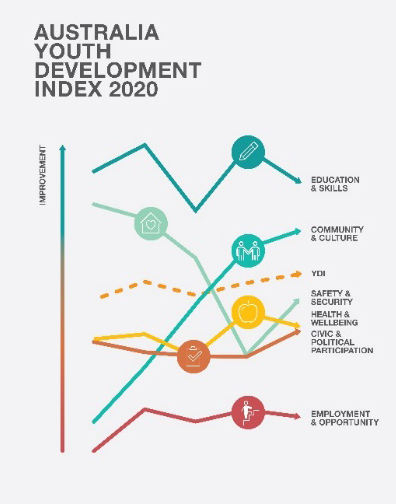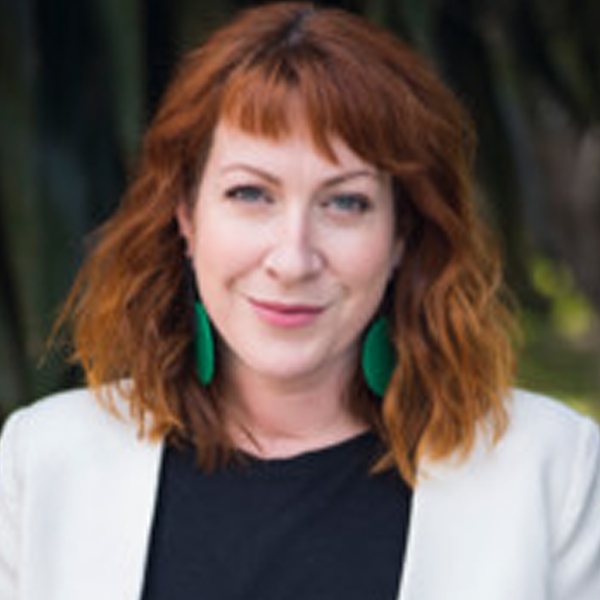In 2019, 13 percent of the Australian population were aged 15-24 years. This period of youth development has the potential to influence the life trajectory for personal health, wellbeing, participation in society and productivity. During this time, a young person will often finish their education or training, get their first job, start active lifestyles, and create positive social connections, which are all fundamental to individual and community wellbeing. Identifying the most vulnerable in society during this key period is particularly important to appropriately target policies and programs, ensuring every young Australian has the opportunity to thrive.
The Global Youth Development Index (GYDI) , ranking 181 countries in regard to youth development, was released this year. The results of the Global YDI have been a shock to some in Australia with our ranking in the YDI and most domains being fairly low for a wealthy, developed nation. It showed that in 2018 we ranked 29th overall, 29th in Education, 61st in Employment and Opportunity, 46th in Equality and Inclusion, 25th in Peace and Security, 3rd in Political and Civic Participation and surprisingly 56th in Health and Wellbeing.
… ensuring every young Australian has the opportunity to thrive.
The Australian Youth Development Index 2020 (AYDI) gives a more focused local picture. Commissioned by the Australian Government, it provides a unique insight into the experiences of the 3.25 million young people aged 15 to 24 between 2015 and 2019. AYDI creates a picture for advocates, researchers, governments and the community to see what is happening with young people and where further research, funding and programs and appropriately target policies may be needed, ensuring every young Australian has the opportunity to thrive.
A unique part of the AYDI was the youth consultations undertaken by youth peak bodies and youth workers in every state and territory. There were 228 young people from 19 regional, rural and urban areas who attended the workshops investigating the YDI Domains, indicators, and priorities from other YDIs, and to evaluate their appropriateness in Australia [1]. Regarding health and wellbeing, the young people noted: [2]
A peaceful and compassionate society where young people can be happy, confident in their own abilities, and live disease-free in a clean and healthy natural environment was the top issue for young people in the consultations. The most pressing goal for this domain is improved education and support services for mental health. This includes learning about emotional wellbeing and interpersonal skills, such as how to resolve issues and build resilience. Young people identified improved access to health services in terms of geographical location, diversity of services, and access to services at no cost as possible ways to improve outcomes for health and wellbeing.
Additional priorities include: addressing drug and alcohol addiction through methods such as parent education; consistency of care through higher retention of health professionals, particularly in remote locations; and improved access to affordable, nutrient-rich whole foods.
The following were listed by two or more consultation groups of young people as a priority for health (listed in order of priority):
- Alcohol or drug abuse
- Access to and engagement with health services including remote areas
- Suicide rates
- Rates of mental health
- Social and family network
- Cost/affordability, including private cover
- Healthcare services
- Mortality rate
- Awareness of services
- Mental and physical health
- Mental health services access.
The four indicators chosen for the AYDI Health and Wellbeing Domain aligned to the priority list given by young people. The AYDI shows that Australia has been progressing in youth development across the domains of Health and Wellbeing, Employment and Opportunity, Civic and Political Participation, and Community and Culture while declining for Education and Skills and Safety and Security. That being said, Health and Wellbeing scores relatively poorly ranking 4th out of these six Domains.

The AYDI shows that Australia had an overall improvement in Health and Wellbeing, reaching 0.478 out of 1 in 2019. In 2019, Victoria (Vic) ranked first followed by South Australia (SA), New South Wales (NSW), Queensland (QLD), Western Australia (WA), Tasmania (Tas), Australia Capital Territory (ACT) and lastly Northern Territory (NT). NT ranked eighth but saw the largest improvement between 2015–2019. ACT saw the largest decline between 2015–2019.[3]
… these may well be issues to focus on …
By looking at the indicators used in the AYDI and Global YDI, Australia can learn how we can improve youth development across the country. The Global YDI uses Mortality Rate, HIV rate, Self-Harm, Mental Health, Drug Abuse and Tobacco Consumption in the calculation of the Health and Wellbeing Domain. Drug Abuse, Mental Health and Alcohol Abuse indicators were all lagging in Australia. That coupled with the High Levels of Psychological Distress and Alcohol Lifetime Risk indicators scoring very poorly in the AYDI suggests these may well be issues to focus on to improve both youth development and our standing in health globally.
While the Australian Health and Wellbeing Domain indicators showed improvement at the National level between 2015-2019 jurisdictional results varied:
- ACT showed deterioration in all four indicators.
- NSW only saw improvement in Alcohol Lifetime Risk but it was a large improvement countering its deteriorations in the three other domains.
- NT only saw deterioration in High Levels of Psychological Distress and the largest improvement in Self-Harm Mortality rates of any jurisdiction.
- Qld showed deterioration in Self-Harm Mortality Rate and High Levels of Psychological Distress but improvement in the other two indicators.
- SA showed deterioration in Self-Harm Mortality Rate and Total Mortality Rate but improvements in the other two indicators.
- Tas showed deterioration in High Levels of Psychological Distress, becoming the worst jurisdiction for this indicator while seeing improvement in all other indicators.
- Vic saw deterioration in Self-Harm Mortality Rate and Alcohol Lifetime Risk but improvements in the other two indicators.
- WA only saw deterioration in High Levels of Psychological Distress while seeing improvement in all other indicators.
The issues facing young people vary across time, geography and demographics. Keeping youth involved in what is measured and used in developing policies and practices is paramount to ensuring effective positive change to the lived experience of our youth.
 Gemma Wood, is CEO, Co-Founder and Principal Statistician of Numbers and People Synergy, founded in 2016 to inform the development of cohesive, practical and effective social development policies and programs that empower decision makers worldwide to deliver solutions to social problems for their communities. Gemma is a statistician and community development researcher with over 20 years of experience in research and consulting roles in the private, public and NGO sectors. She has maintained a focus on increased equity and opportunity for all social groups and particularly marginalised and vulnerable people.
Gemma Wood, is CEO, Co-Founder and Principal Statistician of Numbers and People Synergy, founded in 2016 to inform the development of cohesive, practical and effective social development policies and programs that empower decision makers worldwide to deliver solutions to social problems for their communities. Gemma is a statistician and community development researcher with over 20 years of experience in research and consulting roles in the private, public and NGO sectors. She has maintained a focus on increased equity and opportunity for all social groups and particularly marginalised and vulnerable people.
 Katie Acheson , is Co-Founder and Youth Development Specialist with Numbers and People Synergy. Katie is a subject matter expert in Youth Development and a community engagement specialist, with over 20 years of experience in the community sector, various levels of government and international development organisations. Much of her work has involved designing and implementing interventions to engage, empower and create collaborative communities.
Katie Acheson , is Co-Founder and Youth Development Specialist with Numbers and People Synergy. Katie is a subject matter expert in Youth Development and a community engagement specialist, with over 20 years of experience in the community sector, various levels of government and international development organisations. Much of her work has involved designing and implementing interventions to engage, empower and create collaborative communities.
[2] Numbers and People Synergy, 2021, Australian Youth Development Index 2020, available at: https://www.numbersandpeople.com/aydi2020
[3] Numbers and People Synergy, 2021, Australian Youth Development Index 2020, available at: https://www.numbersandpeople.com/aydi2020
